As a consultant I am involved with customers in various workshops. Typical ones are related to visioning: “what’s next” , prioritization / roadmapping / planning “what’s first”, planning the service (customer needs and Return-of-Investment) “why it’s important” and on some details like User Interface, functionalities, user path “how it works” and so on. Thinking typical 2D meeting we are usually limited to showing a single screen of content along with video, audio and chat. While there would be other possibilities people tend to choose the easiest way.
How Metaverse enables new ways for hybrid and future workshops
We know people usually don’t want to put much effort to the task. It is a generalization and there are exceptions of course. They don’t see the value for them for doing some extra. That is why Immersive Meetings in Microsoft Teams (Mesh for Teams) will make it easy to join the immersive 3D meeting experience. The way Metaverse is going to manifest itself most often in the Microsoft Cloud is by selecting Immersive experience in Microsoft Teams View Switcher.
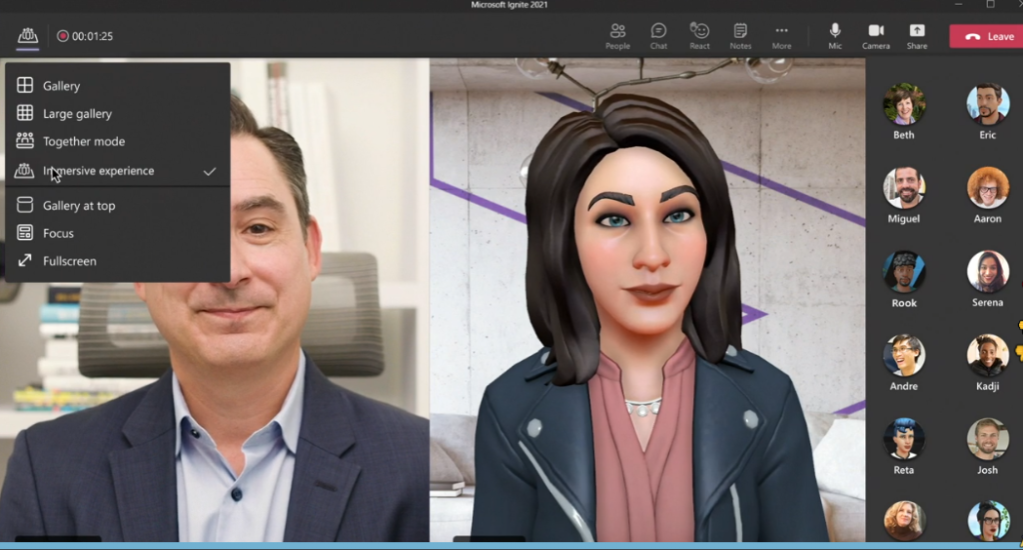
That is something people can do – especially when you don’t need the Virtual / Mixed Reality Headset. You can join the meeting using your computer or even mobile device and it makes starting use of the Metaverse easy for those 250 Million Monthly Active users Teams has.
What benefits workshop in the Metaverse has over 2D meeting?
How I see this get started is that we starting doing workshops in the Metaverse to have have a more “real” feeling compared to the 2D image grids “Hollywood Squares” model. Meetings in Virtual Reality bring people more present (you can see their avatars and interact with them). This has been very present in events done in Virtual Reality, where you can see everyone who is there, represented by their avatars. You have also eye-contact (tracked or faked) which is a very powerful perk: we feel more connected and engaged with other participants.
When you move close to a person (or their avatar, but it is just a digital representation of that person) you can have a conversation with them. The meeting / workshop will look more real in that sense. People are “there”, in the digital representation of the meeting space.
I am not alone in that thought. I have heard that from various community event attendees – despite having less people in the 3D meeting than in the typical meeting it feels better. There is less meeting fatigue – once reason being you don’t have to worry about your hair.
Going towards the workshop needs. What we often have in the workshop
- Display some content, sometimes multiple approaches
- Get feedback
- Work on ideas in small groups
- People tell / post their thoughts; for example in the in person workshop using post-it notes
- Whiteboard gets filled with ideas
- Hands wave when talking
- Emotions (pleased, displeased) can be read from facial expression
- Coffee and snacks
Ok – virtual coffee and snacks are not that fun or tasty. Everyone should bring their own favorite treats for the Metaverse workshop (Bring Your Own Drinks and snacks, BYODs). When everyone is in the same meeting room physically we of course enjoy in-person interaction to the fullest. But it doesn’t mean we should not use these tools to create content directly to the Metaverse (Microsoft Cloud) so we can reuse and work it further later easily.
But for other parts we can do in the Metaverse better than in the 2D meeting version
- Have multiple content displayed on the virtual workshop/meeting space walls. Or hovering over the table. People can view and compare them easily (compared to switching to the new content in 2D meeting, for example). And yes – content can be also 3D models people can twist, rotate and take closer looks at.
- Feedback with audio is quite effective. We can do that in Teams, but the moment more people talk at the same time it doesn’t work that well anymore. Talking over someone is not nice at the Metaverse either, but it is be possible. I do assume that you can also record / transcript Metaverse meetings so feedback can be captured from the transcription afterwards as well.
I would not be surprised to see a Loop components in the Metaverse during early phases – along with speech to text capability or a virtual keyboard. Or if you are not using a headset you could just type your texts in. - Breakout Rooms are quite an easy way to split the party to smaller groups in Microsoft Teams. But in the Metaverse it will be easier just like in the real life: people can form up small groups by themselves and get some distance to others to talk about their ideas.
- Post-It notes in the virtual world can be done with a Whiteboard. That whiteboard, unlike the one in the real world has no limits. Or perhaps you want to add an second whiteboard, even during the meeting if you want to. If you are an experienced Metaverse facilitator it should be easy.
- Whiteboard can make a big difference compared to the traditional 2D meeting:
- People can see who is where in the whiteboard (despite collaborative cursors)
- People outside the immersive meeting can also participate
- You can see other content easily when you participate in the board (multiple content in the space, instead of a single share)
- Post it-notes, voting, inking, Loop-components, ideas, typing, pictures and so on. Whiteboard can be quite a rich multi-purpose canvas embedded in the Metaverse.
- Of course you can use Microsoft Whiteboard in 2D meeting as well, but having it embedded inside the Metaverse makes it will more “real” and “present” in the room – usability in 2D version is easier though. Nothing is stopping you from combining these both to Metaverse Workshops.
- Hands and emotions : how you can do this without a VR/MR headset? Perhaps Mesh for Teams could use just webcam to read people’s emotions and hand movements? Once that tech is included it would make it truly immersive and inclusive – if you don’t have to buy any new devices and it would also work on mobile device’s cams. I mentioned eye-contact already: think traditional 2D meeting and how many times you have eye-contact with everyone. A good facilitator or presenter can do that (with good camera setup) but not everyone in the room. Even faked eye-contact will create the feeling of being engaged.
- Early tech version will probably let you use reactions in Teams meetings to deliver digital twin responses
- If you are using a VR/MR headset it would make you also more focused to the workshop since you could not multitask at the same time (at least not that easily)
- Thinking back my in person meeting I visited a few weeks back (CollabSummit 2021) I noticed I really hoped I would have had a Google glass or some other MR device that would have highlighted people’s names to me. That is one thing Metaverse will do better than in-person: when you are in the room with new people, it may not be easy to remember everyone’s names: Immersive meeting experience can highlight you names (like AltSpace VR and about all platforms do now) and possibly get even more information about the person if we want to.
- As a bonus I vision that you can add Teams meeting applications to the Metaverse – designing these apps to work with touch-interface will add to the meeting – allowing to add business process applications to the workshop to extend and enhance the experience even more. And reducing people’s already filled To Do lists – why wait when you can do it already during the meeting?
With all these – I do see that workshops in the Metaverse would have big benefits over traditional 2D meetings the are done currently. Just a reminder: check this video out (yes, I have posted this one earlier) but it does highlight these points:
And as a bonus, we should not forget the translation capability that will emerge there as well eventually.
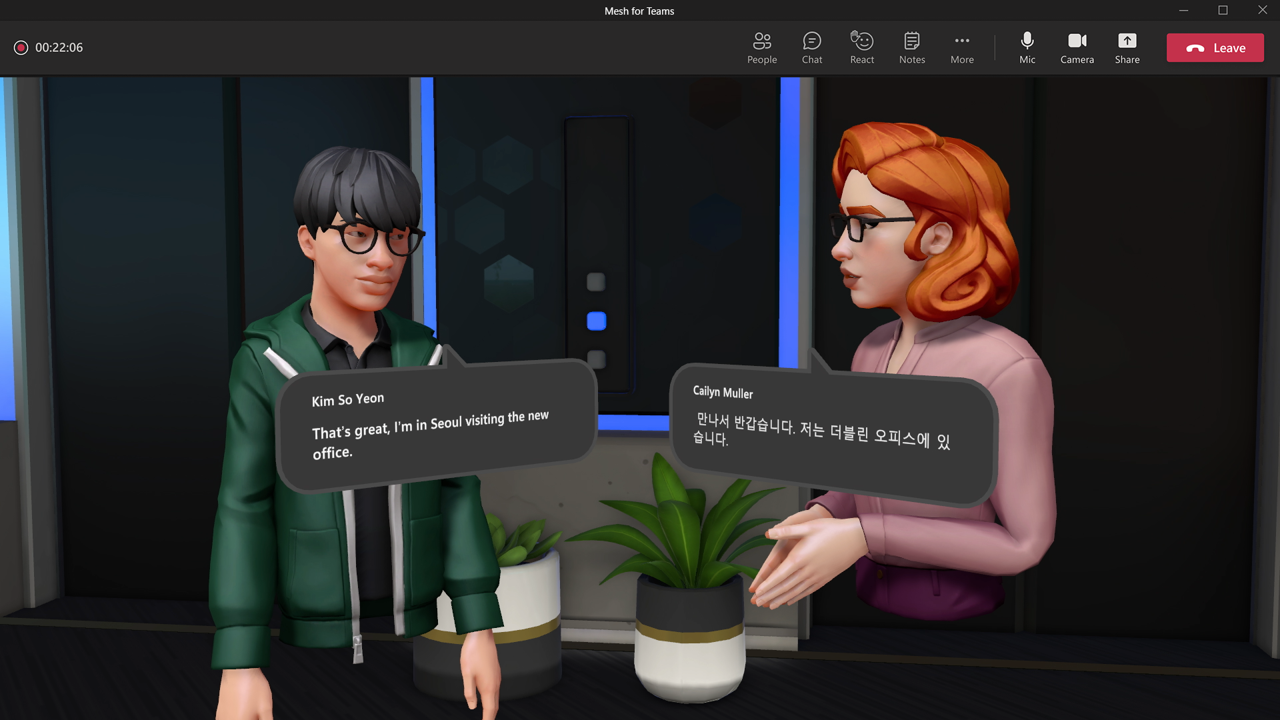
And voting / raise hand might be as easy as raising your hand. In real life and that is expressed by your digital twin avatar.
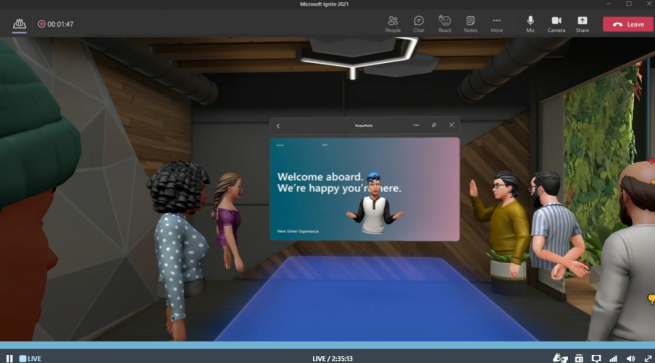
Some recent conversations I had also made me think about Meeting Rooms and Hybrid meetings. Perhaps you have an Microsoft Teams Room where some portion of workshop attendees are and the rest are in different offices and/or scattered online. For people seeing in-person this means that their interaction is going to be different from others. I don’t think it is a coincidence that Microsoft is putting out as a good practice to have everyone in the room join the meeting with webcam on & audio off using their Laptop of other device. Currently this brings everyone more present to online attendees (despite the room) but also enables everyone to work on digital content using their device. In Metaverse other attendees would get their reactions to the Metaverse as well. Probably even Teams Room video will be included as a screen: virtual hybrid meeting room inside Metaverse. Now, that is an interesting idea – unless holoprojection can be managed to bring people from physical room (using cameras) to Metaverse. While this may sound far-fetched this is about digitalization of cameras and brining them as holo-avatars to the room; this is one of my visions I think will be closer than generally thought.
But holo-avatar or not – using Microsoft Cloud integrated tools like Surface Hub and Office 365 enables everyone to work and see the same content – are they in the Metaverse, in physical meeting room or working from other offices or locations.
Future meetings need planning as well
Of course there are worries how this all will emerge when Mesh for Teams launches.
Not all features will be out there in the first version but it is technology. How will this run on low-end devices? What kind of mobile device will be needed? How people know how to move and interact in the Metaverse? How they can type when wearing a headset? What about meeting fatigue when sitting 8 hours in the 3D world with the headset?!
To this last question: you don’t. 8 hour intensive meeting days are very rough in the real world as well.
Have breaks. Have shorter meetings/workshops.
Immersive experience doesn’t mean you spend 100% of your time to there (in the matrix 🤭).
One very important aspect is that meeting culture requires change for both traditional 2D and immersive meetings. First: Use intelligent meeting lifecycle where you do work outside meetings as well, using that Whiteboard outside the meeting. Not everything needs to happen when we are there together – only the parts that require interaction and add for benefits. Workshops need to be prepared, attendees should work on their parts of materials before the meeting. During the workshop new ideas and prioritization happens, as well as open Q&A and evolving the outcome. After the meeting work continues – perhaps there are follow-up meetings as well.
We have these tools – let’s use them.
The Metaverse meeting space will very like be persistent as well as 2D Teams meeting: after all immersive experience is just an another view to the meeting what we use. You can go there early or afterwards, invite some colleague to work some ideas with you or work there alone (perhaps focusing on content more with the headset, or working on them using other programs).
Meeting is not limited to a single point of time.
This this post I talked focusing on workshops, where we create, collaborate, ideate and prioritize the outcome. It is very easy to expand this idea to training and learning parts – even without going to digital twins of an airplane engine or building. This sounds like I will be writing an another post from that aspect.
Tech improves over the time but you need to plan and adopt the change to get benefits
2019 we didn’t think this would happen so soon, despite I have to say I was visioning 2016 that 3D world would be quite commonplace in 2021. I almost nailed that prediction, missed by one year only. This future will be more awesome than we thought. Tech like Loop, Context IQ, Azure services (speech to text, text to speech), Azure Remote Rendering, applications planned with touch interface and so on help also us to work and create together in the Metaverse. I also vision that you can bring in Teams meeting applications to the Metaverse experience one day – that way you can have business process inside the workshop/meeting in the Metaverse and it also means that if you have not started to plan your business process / LOB Teams meetings applications yet.. you need to start putting them to the roadmap.
Tech and possibilities it offers improve over time. Make sure you and your organization are already planning how to use the Metaverse.
Benefits don’t happen automatically.
Like all other pieces of tech it needs to have benefits to people and why it is used. Adoption and learning play key roles as well as Champions and Champion Metaverse Facilitators networks. Keeping up skills requires continuous learning of both how but also why. That is why it is already time to start learning about the Metaverse and how you plan to integrate it to your business.
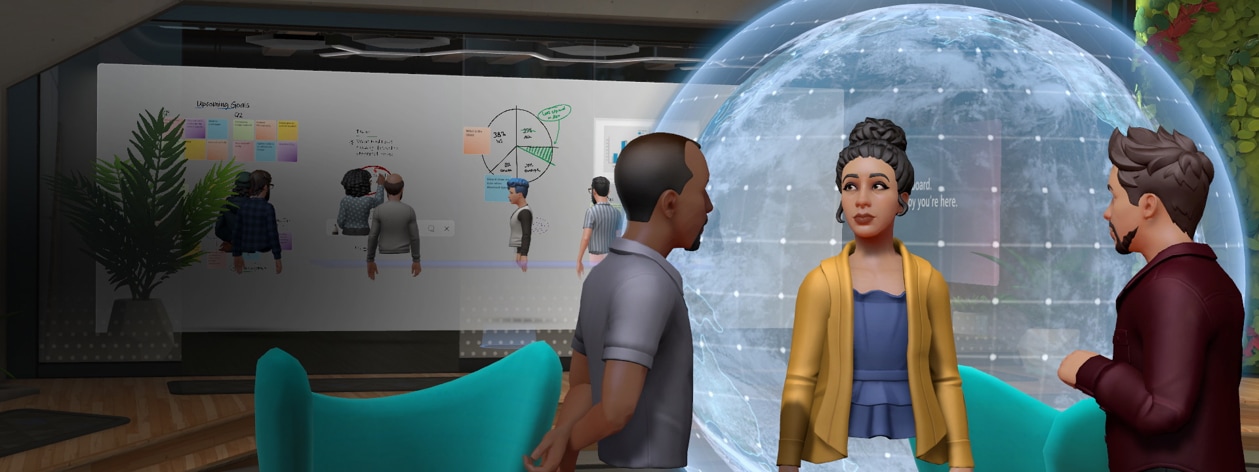
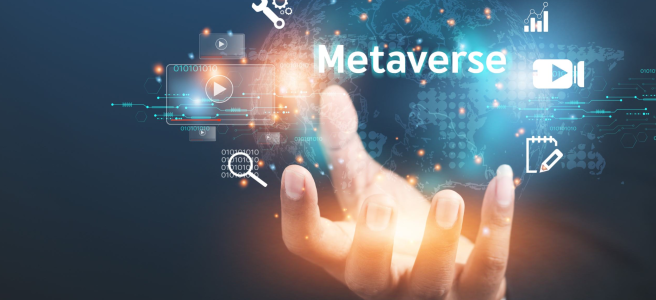
3 thoughts on “How we work and collaborate in the future: Workshops in the Metaverse”